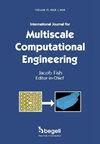VERIFICATION AND VALIDATION OF A RAPID DESIGN TOOL FOR THE ANALYSIS OF THE COMPOSITE Y-JOINT OF THE D8 DOUBLE-BUBBLE AIRCRAFT
IF 1.4
4区 工程技术
Q2 ENGINEERING, MULTIDISCIPLINARY
International Journal for Multiscale Computational Engineering
Pub Date : 2023-01-01
DOI:10.1615/intjmultcompeng.2023047801
引用次数: 0
Abstract
Polymer composite joints are critical aerospace components for reinforcing lightweight structures and achieving high eco-efficiency transportation standards. Optimizing complex structural joints is an iterative process. Fast and reliable numerical approaches are needed to overcome the runtime limitations of high-fidelity finite element (FE) modeling. This work proposes a computationally efficient approach based on the design tool, HyperX. Verification against FE models and experimental validation are presented for the composite Y-joint in the D8 double-bubble fuselage. Results show that the failure load of the Y-joint is predicted within 10% of the experimental failure load recorded. Two parametric studies are performed to study the effects of the curvature of the joint (110-160 deg) and the skin thickness (16, 24, and 32 ply) in the failure load predictions using a stress-based failure criterion. The maximum failure load occurred for a Y-joint with 130 deg curvature. The 32-ply skin Y-joint was predicted to have the highest failure load. Results prove the applicability of rapid joint optimization analysis for faster, computationally efficient design.d8双泡飞机复合材料y形接头快速分析设计工具的验证与验证
聚合物复合接头是增强轻型结构和实现高生态效率运输标准的关键航空部件。复杂结构节点优化是一个迭代过程。为了克服高保真有限元(FE)建模的运行时间限制,需要快速可靠的数值方法。这项工作提出了一种基于设计工具HyperX的计算效率方法。对D8双泡机身复合材料y型接头进行了有限元模型验证和实验验证。结果表明,预测y形接头的破坏载荷在实验记录破坏载荷的10%以内。使用基于应力的失效准则,进行了两个参数研究,以研究关节曲率(110-160度)和蒙皮厚度(16,24和32层)在失效载荷预测中的影响。最大破坏荷载发生在曲率为130度的y形接头上。预计32层蒙皮y形接头具有最高的失效载荷。结果证明了快速联合优化分析对于更快、计算效率更高的设计的适用性。
本文章由计算机程序翻译,如有差异,请以英文原文为准。
求助全文
约1分钟内获得全文
求助全文
来源期刊
CiteScore
3.40
自引率
14.30%
发文量
44
审稿时长
>12 weeks
期刊介绍:
The aim of the journal is to advance the research and practice in diverse areas of Multiscale Computational Science and Engineering. The journal will publish original papers and educational articles of general value to the field that will bridge the gap between modeling, simulation and design of products based on multiscale principles. The scope of the journal includes papers concerned with bridging of physical scales, ranging from the atomic level to full scale products and problems involving multiple physical processes interacting at multiple spatial and temporal scales. The emerging areas of computational nanotechnology and computational biotechnology and computational energy sciences are of particular interest to the journal. The journal is intended to be of interest and use to researchers and practitioners in academic, governmental and industrial communities.

 求助内容:
求助内容: 应助结果提醒方式:
应助结果提醒方式:


